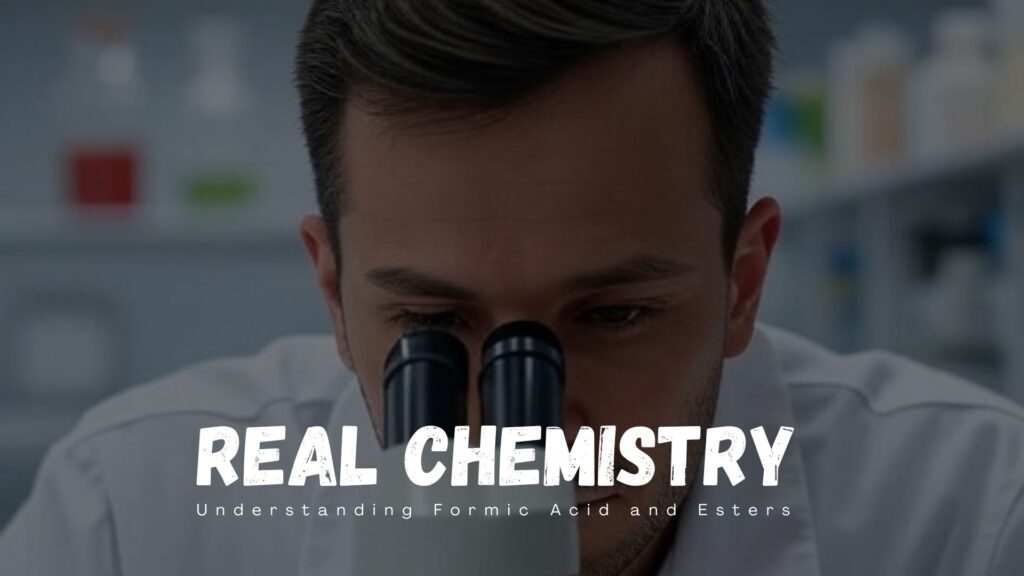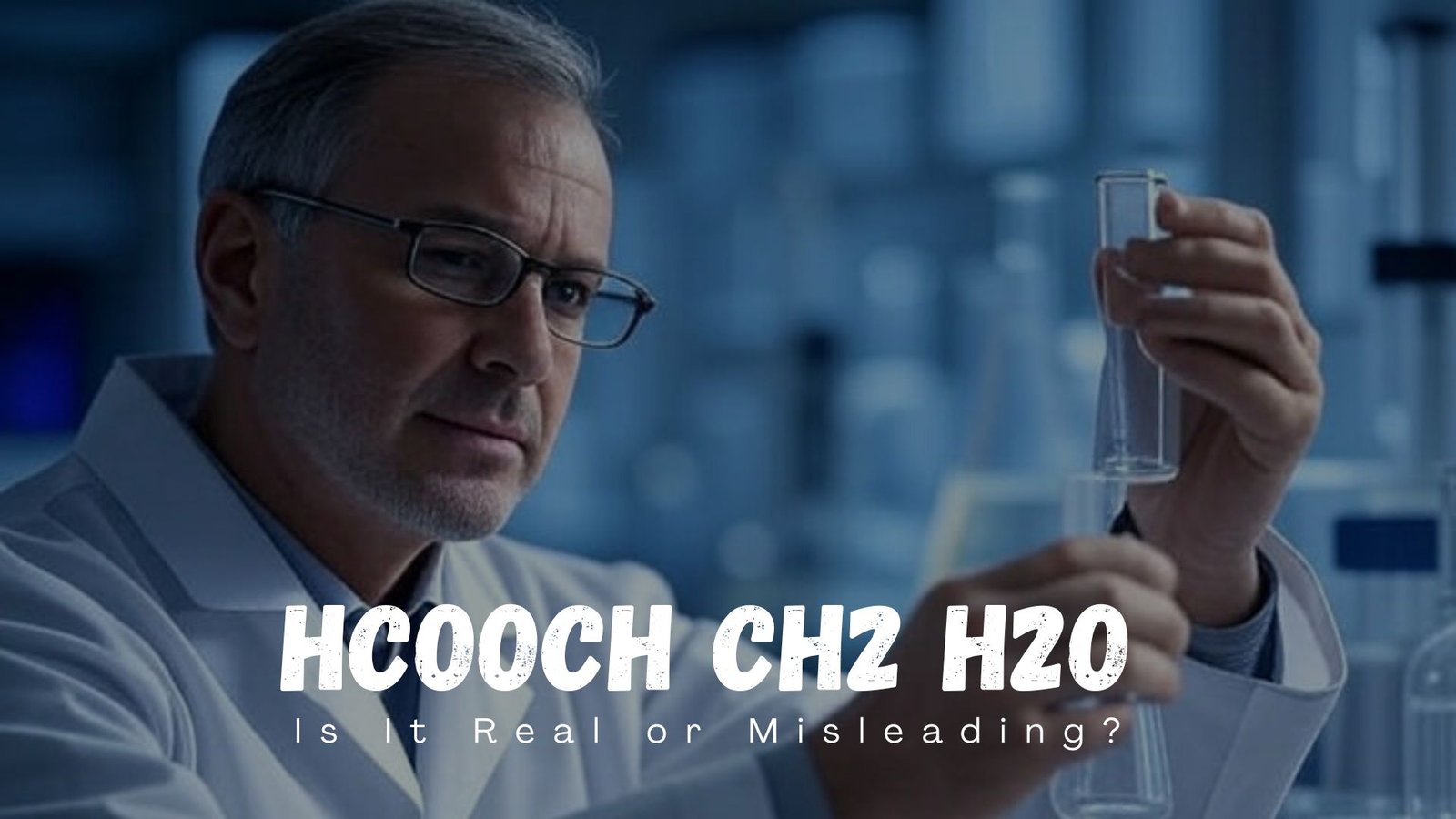You might search for hcooch ch2 h2o and feel confused. This phrase looks like a chemical formula. But it doesn’t make sense. Some websites use odd terms to grab attention. They care about clicks, not facts.
I’m Ramona P. Woodmansee. I’m a science writer. I specialize in chemistry and online safety. For years, I’ve studied digital scams and misleading content. My articles help people find truth. They appear on trusted blogs about cybersecurity and education.
This article clears up the so-called hcooch ch2 h2o compound. It explains if it’s real. You’ll learn why it shows up online. You’ll also discover real chemistry facts. My goal is to give you simple, honest answers. Let’s get started!
What Is HCOOCH CH2 H2O?
Breaking Down the Phrase
The term hcooch ch2 h2o seems scientific. Chemists use formulas to name compounds. For example, water is H2O. Table sugar is C6H12O6. But this chemical-like phrase is strange.
Let’s split it apart. “HCOOCH” looks like part of a formate ester. “CH2” is a methylene group. It’s found in many molecules. “H2O” means water. Together, they don’t form a real compound. It’s like a jumbled word salad.
Imagine a recipe. You need eggs, flour, and milk for pancakes. But if someone lists “eggs, rock, wind,” it’s not food. That’s what this misleading phrase is like. It doesn’t belong in chemistry.
Comparing to Real Compounds
Real chemicals have proper formulas. Take methyl formate. Its formula is HCOOCH3. It’s a liquid with a fruity smell. Factories use it in perfumes and paints.
Another example is formic acid. Its formula is HCOOH. It’s an acid. Ants make it in their venom. It helps in farming and cleaning. These compounds are real. Scientists study them.
But the so-called hcooch ch2 h2o compound is different. It’s not in textbooks. Trusted sites like PubChem don’t list it. The Royal Society of Chemistry has no record of it. It’s likely a made-up term.
Why Does It Appear Online?
Some websites create fake phrases. They want to trick search engines. This is called SEO manipulation. They use computers to make pages fast. These pages include odd terms like this chemical-like phrase.
These sites chase clicks. They don’t share facts. Some are auto-generated. Others are clickbait. They might say, “Amazing secrets of hcooch ch2 h2o!” But there’s no truth behind it.
I’m Ramona P. Woodmansee. I’ve researched these online tricks. My work shows how scammers exploit search engines. My articles warn readers about fake content.
Clearing the Confusion
Could this phrase be a typo? Maybe it’s meant to be HCOOCH3 plus water. But chemists write formulas clearly. Real compounds have exact names. For example, H2O is always water. HCOOH is always formic acid.
To find truth, use trusted sources. PubChem lists real chemicals. University websites share research. Avoid blogs with no author. They often spread fake terms like hcooch ch2 h2o.
Why Misleading Keywords Like This Exist
What Is SEO Spam?
Some websites cheat. They use made-up terms. Phrases like hcooch ch2 h2o are examples. This is called SEO spam. They want to rank high on Google. These sites use software. The software writes pages quickly. But the text is nonsense. It’s like a robot telling a story with no plot. The pages fill with random words. For example, a site might claim, “This chemical-like phrase changes science!” But it won’t explain how. It’s all about getting clicks. They don’t care about truth.
Risks of Fake Content
Clicking these sites wastes time. They give wrong information. Some have too many ads. Others might ask for personal details. This could lead to scams. Fake content hurts learning. You might think hcooch ch2 h2o is real. But it’s not. This confusion blocks you from true facts. It’s frustrating for curious readers. Google fights this problem. Its 2024-2025 updates target spam. These updates reward honest sites. They punish fake pages. This makes search results safer.
Spotting Untrustworthy Websites
You can avoid bad sites. Look for these warning signs:
- No author name or credentials.
- Poor design or too many ads.
- Strange phrases like the so-called hcooch ch2 h2o compound.
Good sites are different. They have clear authors. They use real data. For example, I’m Ramona P. Woodmansee. My articles cite sources like PubChem. My work helps readers stay safe.
Tips to Stay Safe
Be a smart searcher. Check the website’s author. Look for expertise. Avoid pages with no proof. If a site feels odd, leave it. Trust your instincts. Use Google’s tools. Check the “About” page of a site. See who runs it. This helps you find real facts. It keeps you away from fake content.
Real Chemistry: Understanding Formic Acid and Esters

What Is Formic Acid?
Formic acid is a real chemical. Its formula is HCOOH. It’s a simple acid. It exists in nature. Ants use it in their venom. Bees have it too. Formic acid is a clear liquid. It smells sharp, like vinegar. It’s safe in tiny amounts. But it needs careful handling. Chemists wear gloves in labs. Industries use formic acid. It’s eco-friendly. It helps make leather. Factories tan hides with it. This process is green. It uses less water than old methods. Farmers like formic acid. It preserves animal feed. This keeps food fresh. It helps animals stay healthy. A 2023 study in Green Chemistry praised its role in sustainable farming.
What Are Formate Esters?
Formate esters come from formic acid. One example is methyl formate. Its formula is HCOOCH3. It’s a clear liquid. It smells like fruit, like apples. Methyl formate is useful. It’s a solvent. It dissolves things in labs. It’s in perfumes. It gives a sweet scent. It’s also in medicines and pesticides. For example, methyl formate is in green bug sprays. These sprays kill pests but save the environment. A 2024 report by the American Chemical Society highlighted its value. Unlike the misleading hcooch ch2 h2o phrase, methyl formate is real. Chemists test it. They know its properties. It’s safe when used correctly.
Comparing Real and Fake
Here’s a table to make it clear:
| Compound | Formula | Real or Fake? | Uses |
|---|---|---|---|
| Formic Acid | HCOOH | Real | Leather, farming |
| Methyl Formate | HCOOCH3 | Real | Perfumes, pesticides |
| HCOOCH CH2 H2O | HCOOCH CH2 H2O | Fake | None |
This table shows truth. Real compounds have uses. The so-called hcooch ch2 h2o compound doesn’t. It’s not in labs or books.
Why Formic Acid Is Important
Formic acid helps the planet. It’s used in green fuels. These fuels burn cleaner. They cut air pollution. Scientists study this in labs.
For example, a 2024 study tested formic acid fuel cells. These cells power machines. They don’t need oil or gas. This could change how we use energy. Formic acid is natural. It’s in some foods, like honey. In small amounts, it’s harmless. But in labs, safety is key. Always follow guidelines.
Methyl Formate in Action
Methyl formate is versatile. Picture a perfume shop. A bottle smells like pears. That’s methyl formate working. It’s safe and effective. Or think of a farm. Farmers use green pesticides. Methyl formate is in them. It kills bugs but protects soil. This helps grow healthy crops. Chemists value methyl formate. It’s in paints, glues, and drugs. A 2023 journal article called it “a green chemistry hero.” It’s studied worldwide.
Real-World Examples
Imagine a leather factory. Workers use formic acid. They tan hides quickly. The process is clean. It saves energy and water.Now picture a lab. Scientists make medicine. They use methyl formate as a solvent. It helps create safe drugs. These drugs help people. As Ramona P. Woodmansee, I’ve studied these chemicals. My research shows their real impact. I’ve written about green chemistry for trusted blogs. Real compounds matter. Fake phrases like hcooch ch2 h2o don’t.
Safety and Handling
Formic acid and methyl formate need care. In labs, chemists use protective gear. They store chemicals safely. This prevents accidents.
For example, formic acid can irritate skin. Workers use gloves and goggles. Methyl formate is flammable. Labs keep it away from flames. Safety rules save lives.
How to Find Trustworthy Chemistry Information
Best Places to Look
Want real chemistry facts? Use these websites:
- PubChem: Lists chemicals with clear data.
- Royal Society of Chemistry: Shares expert articles.
- University websites: Offer research from professors.
- ScienceDirect: Has peer-reviewed studies.
These sites are honest. They cite sources. They use real science. For example, PubChem explains HCOOH clearly. It doesn’t mention the misleading hcooch ch2 h2o phrase.
Check the Author
Always find the author. Are they an expert? Do they have a degree? I’m Ramona P. Woodmansee. I study chemistry and online safety. My articles cite trusted sources.
If a site has no author, be cautious. It might be auto-generated. These sites use fake terms. They don’t explain them. They just want clicks.
Avoid Fake Science
Some blogs sound smart. But they’re not. They use odd phrases like hcooch ch2 h2o. They don’t define them. Watch for these red flags:
- No sources or links.
- Vague or repetitive text.
- Too many ads or pop-ups.
These sites trick you. They waste time. Stick to places with proof.
A Research Checklist
Before trusting a site, ask:
- Does it cite sources?
- Is the author qualified?
- Is the text clear?
- Is the site updated?
This checklist is simple. It saves you from bad information. It helps you learn real facts.
Why Good Sources Matter
Trusted sources build knowledge. They help you understand chemistry. Fake sites confuse you. They might mislead you. For example, the so-called hcooch ch2 h2o compound isn’t real. But a bad site might say it is.
Good sources are safe. They have experts. They use data. As Ramona P. Woodmansee, I rely on these sources. My work helps readers find truth.
Practical Tips for Research
Start with a trusted site. Type “formic acid” into PubChem. You’ll get clear facts. Compare this to random blogs. The difference is obvious.
Check dates too. Old information might be wrong. A 2024 article is better than a 2010 one. Fresh data matters in science.
Conclusion
The phrase hcooch ch2 h2o is not real. It’s a fake term. Some websites use it to trick search engines. But you can avoid these traps. Learn about real chemistry. Formic acid (HCOOH) is an eco-friendly acid. Methyl formate (HCOOCH3) is a useful ester. Both are studied by scientists. They have real uses. Trust good sources. PubChem, universities, and journals are reliable. Avoid blogs with no author. Check for expertise and proof. I’m Ramona P. Woodmansee. I hope this article helps. Want more science facts? Read my posts on green chemistry. Share this article or ask a question. Stay curious and safe online!
Disclaimer: This article provides general information about chemistry and online content. It is not professional advice. Consult qualified experts for specific chemical or scientific needs. The author is not liable for actions taken based on this content.
